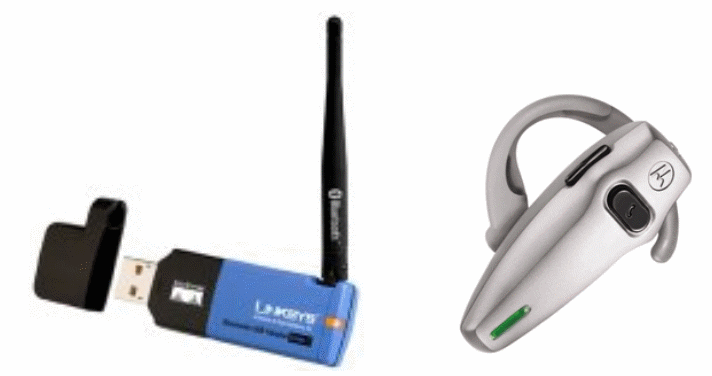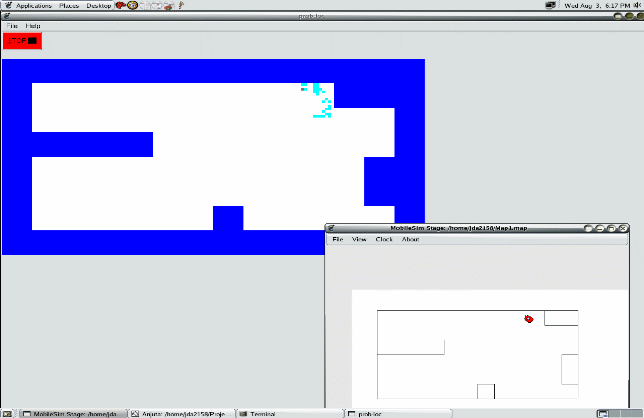
Research Experiences for Undergraduates in Distributed Rational Agents
Open House 2005

Four undergraduate participants of the REU summer program participated in the REU Open House 2005 to present their research projects.
Voice-Control Interface for Intelligent Environments
 The
goal of this project was to develop a robust system for voice
control for intelligent environments. Such a voice control interface
addresses one of the important issues in smart homes, namely the
availability of an easy to use and natural interface between the
human inhabitant and the devices in the home. The main challenges
that had to be addressed for this project were the fact that the
system has to operate in the context of ambient noise and in an
environment where multiple people might have conversations or where
radio or television might introduce conversations that can be on
arbitrary topics. The latter leads to the problem that any set of
key words used to identify commands might occur naturally during
conversation but should be interpreted as commands only when they
are intended as such.
The
goal of this project was to develop a robust system for voice
control for intelligent environments. Such a voice control interface
addresses one of the important issues in smart homes, namely the
availability of an easy to use and natural interface between the
human inhabitant and the devices in the home. The main challenges
that had to be addressed for this project were the fact that the
system has to operate in the context of ambient noise and in an
environment where multiple people might have conversations or where
radio or television might introduce conversations that can be on
arbitrary topics. The latter leads to the problem that any set of
key words used to identify commands might occur naturally during
conversation but should be interpreted as commands only when they
are intended as such.
During the summer, one REU participant investigated techniques for voice recognition and developed a system built around the Sphinx voice recognition package. To address the issues of control in the context of a smart home, the student extended this system with components for the detection of conversations by extracting the context in which command key words were used. Only commands that were used in the correct context were interpreted as such. In addition, the student added a flexible, easy to configure interface that connects commands to devices and that allows to easily add and remove devices and device commands from the system. The voice command system uses a Bluetooth headset as its input device to allow for the human to move freely through the home. The figure shows the hardware used to interact with the voice control system.
Smart Shelf - Item Tracking for a Smart Kitchen
 This
project built on the hardware and software developed during previous
REU projects and was aimed at developing an item tracking system
that allows a kitchen closet to keep track of the items available
and their quantities. To do so it takes advantage of load cells
under the shelves and of an RFID tag reader within the closet. Over
the summer, one REU participant investigated techniques for
automatic calibration, load estimation, and efficient weight
assessment for individual items taken from a shelf with load cells
as shown in the figure.
This
project built on the hardware and software developed during previous
REU projects and was aimed at developing an item tracking system
that allows a kitchen closet to keep track of the items available
and their quantities. To do so it takes advantage of load cells
under the shelves and of an RFID tag reader within the closet. Over
the summer, one REU participant investigated techniques for
automatic calibration, load estimation, and efficient weight
assessment for individual items taken from a shelf with load cells
as shown in the figure.
The student developed algorithms to provide for RFID reading on demand, triggered by conditions indicating the potential of change to the content to the closet and determined by monitoring the door and weight sensors. Furthermore, he developed algorithms to filter and integrate the readings from different sensors to try to account for situations where multiple items were removed or added to a shelf simultaneously.
Robot Localization
 To
allow intelligent environments to be of maximum utility, it is
important to provide for the potential for service robots to operate
within these environments and to interact with the inhabitants. One
of the most basic capabilities of such systems is here their ability
to localize themselves and thus determine their location within the
environment. For this project, one REU participant investigated
methods for mobile robot localization and implemented a Monte Carlo
sampling-based localization system for a Pioneer 2 mobile robot
using only sonar information. For this he developed and implemented
particle filter algorithms and integrated them into the robot's
operating environment. The figure shows the developed system
together with the robot simulator. The blue blocks in the robot
localization screen at the top of the screenshot here indicate
potential locations for the robot while the black dot indicates the
actual location.
To
allow intelligent environments to be of maximum utility, it is
important to provide for the potential for service robots to operate
within these environments and to interact with the inhabitants. One
of the most basic capabilities of such systems is here their ability
to localize themselves and thus determine their location within the
environment. For this project, one REU participant investigated
methods for mobile robot localization and implemented a Monte Carlo
sampling-based localization system for a Pioneer 2 mobile robot
using only sonar information. For this he developed and implemented
particle filter algorithms and integrated them into the robot's
operating environment. The figure shows the developed system
together with the robot simulator. The blue blocks in the robot
localization screen at the top of the screenshot here indicate
potential locations for the robot while the black dot indicates the
actual location.
Intelligent Decision Support for a Face Recognition-Based Biometric Entry System
The goal of this project was to augment the face recognition system developed by previous REU participants to facilitate more robust identification for the purpose of entry to a home and to augment it with other biometric identification capabilities. For this purpose, one REU participant investigated modern techniques to assess the reliability of a face identification and developed a system that provided such estimates and based on this estimate made entry decisions. Based on the resulting estimate of reliability, the system could either grant access, deny access, or determine the necessity for further biometric identification such as through a finger or voice print. To achieve this, the system first learns to extract an estimate of the quality of the face identification from the distance parameters in the Eigenface-based face recognition system. This is then subsequently used to make decisions about the correct course of action for the entry system based on a rule based expert system.
For additional information regarding this program please contact:
Manfred Huber
University of Texas at
Arlington
Department of Computer Science and Engineering
Box
19015
Arlington, TX 76019-0015
Email: reu@cse.uta.edu
* This project is funded by NSF grant EIA-0139564